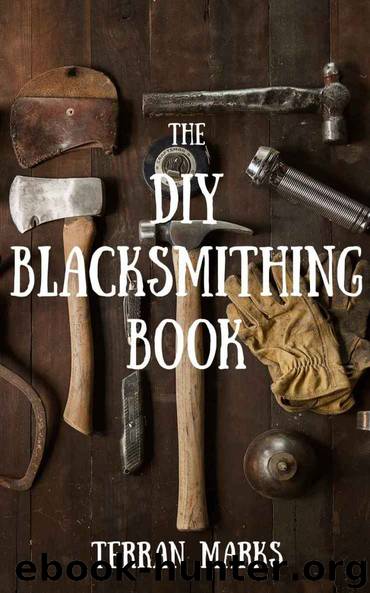The DIY Blacksmithing Book (Blacksmith Books 1) by Terran Marks

Author:Terran Marks [Marks, Terran]
Language: eng
Format: epub
Publisher: Terran Marks
Published: 2015-04-21T05:00:00+00:00
One thing to consider about I-beams is that they have a slender web (the vertical part connecting the flat flanges). This may not distribute the force of your hammer blows very evenly leading to an overly bouncy face.
You want to get the most bang for your buck when you’re directing your blows. Having the piece you’re working on and your hammer bounce around is inefficient.
The Final Word on Makeshift Anvils
For the money, about $30 as I write this, a piece of railroad track should suit your needs just fine. If you have an itch for tinkering, you can modify your piece of track with grinders, cutting torches, and welding equipment to create a horn and a more typical anvil shape.
Anvil Size
When it comes to anvils, bigger and heavier is generally better. The heavier the anvil is the better it will withstand the amount of work you want to do with it.
Weight is important. You don’t want to hammer on large bar stock with a small 40 lb. anvil below it. You’ll wear out the anvil in a hurry.
Here are some guidelines:
· 40 lb. anvil: Use ¼” stock or smaller.
· 50 – 100 lb. anvils: Up to 1” stock.
· 150 lb. anvils and up: Use these bigger guys for stock larger than 1 ½”.
A Quick Note on Anvil Height
To save your elbows and your back, spend a few minutes measuring your anvil height. Follow these steps and you’ll be golden:
1. With your arms at your sides, make a fist.
2. Using a tape measure, find the distance from the floor to the knuckles of your clenched fist.
3. This is where the top of your anvil should be. When it’s set on its stand or stump, the knuckles of your striking hand should rest on its face.
Next Steps
· In the US, look at Craigslist for anvils in your area. You can type “anvils” in the left-hand search box and select ‘For Sale.’ You might be surprised at what pops up.
· Scout out railroad track on eBay.
· Don’t buy an ASO.
· Get creative. What other items are available to you that you could use as an anvil? I’ve seen Ethiopian blacksmiths use a claw hammer and a rock to forge steel. That’s the type of ingenuity I love!
Download
This site does not store any files on its server. We only index and link to content provided by other sites. Please contact the content providers to delete copyright contents if any and email us, we'll remove relevant links or contents immediately.
On Writing A Memoir of the Craft by Stephen King(4847)
The Doodle Revolution by Sunni Brown(4667)
A Simplified Life by Emily Ley(4079)
Mummy Knew by Lisa James(3620)
Marijuana Grower's Handbook by Ed Rosenthal(3606)
Better Homes and Gardens New Cookbook by Better Homes & Gardens(3509)
Figure Drawing for Artists by Steve Huston(3360)
Paper Parties by Erin Hung(3354)
Draw Your Day by Samantha Dion Baker(3256)
The Genius of Japanese Carpentry by Azby Brown(3209)
Japanese Design by Patricia J. Graham(3097)
The Code Book by Simon Singh(3055)
Dangerous Girls by Haas Abigail(2955)
Lions and Lace by Meagan Mckinney(2911)
The Curated Closet by Anuschka Rees(2896)
How to Make Your Own Soap by Sally Hornsey(2812)
The Checklist Manifesto by Atul Gawande(2760)
The Wardrobe Wakeup by Lois Joy Johnson(2717)
Zero to Make by David Lang(2716)
